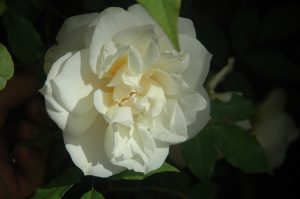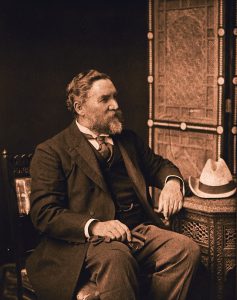Born on the 24th of April 1851 in Old Meldrum, Aberdeenshire, Scotland. He was educated at the Grammar School, King’s College and Marischal College, Aberdeen, and later attended both the University of Aberdeen and the University of Glasgow, eventually graduating as a Doctor of Medicine. After graduating he took the teaching role of prodissector to Professor of Anatomy, Dr Allen Thomas, at Glasgow University in 1873.
He was recommended for the post of Professor of Botany at Calcutta University by Sir Joseph Dalton Hooker. He accepted and moved to India in late 1873. Once in India he did not take up the post in Calcutta and instead accepted a botany professorship in Bengal, a post he held until 1884.
As part of the Indian Government service he had a number of other roles.
- Burma-Manipur Boundary Commission as Medical Officer, 1882
- Scientific Assistant Secretary, Government of India, 1881
- in charge of the India Section of the Calcutta International Exhibition, 1884
- Commissioner, Colonial and Indian Exhibition, London, 1885–86
- Reporter to Government of India on Economic Products, 1887–1903
- Governor of Imperial Institute, 1892
- Editor, The Agricultural Ledger, 1892–1903
- President, Pharmacological Section of the Indian Medical Congress, 1894
- in charge of Calcutta Industrial Museum, 1894-03
- Honorary Secretary, Indigenous Drug Committee of India, 1901
- Director, Indian Art Exhibition, Delhi, 1903
Probably his magnum opus was A Dictionary of the Economic Products of India. The 9 parts published between 1889-1893 are regarded as the greatest compilation of commercial plants in India and covers both agricultural and non-agricultural plants. An abridged version called The commercial products of India is available online.
Sir George Watt is credited with devising a system of where numbered tags were detached from a field book and could be tied to specimens as they were collected in the field. This made it much simpler to correctly identify the correct specimen with the correct entry in a field book. His system became widely used.
Sir George Watt also published an article Tea and the Tea Plant looking at the commercial varieties of Tea grown in India in the Journal of the Royal Horticultural Society 32 page 64-93 (1907). The specimens used to illustrate the varieties are held at Royal Botanic Garden Edinburgh.
For his services to Indian botany and science he was knighted in 1903.
From his time in India he amassed a sizable personal herbarium of around 20,000 collections which were donated to the Royal Botanic Garden Edinburgh. It contains over 150 Type specimens of Indian taxa described by Watt and others.
The archive at Royal Botanic Garden Edinburgh also holds Watt’s glass plate negative collection of images mostly from his time in India. These contain images relating to his work on Economic Botany, his field collection, temples, architecture and scenes from the country.
!['Darjeeling Tukvar tea state manager's bungalow. [c. 1880] Sir George Watt's Indian images. Archive Royal Botanic Garden Edinburgh](http://stories.rbge.org.uk/wp-content/uploads/2014/06/4dm28Wattsm-300x247.jpg)
‘Darjeeling Tukvar tea state manager’s bungalow. [c. 1880]
Sir George Watt’s Indian images. Archive Royal Botanic Garden Edinburgh
!['Coolies plucking' [c. 1880s] In Sir George Watt's Indian images. Archive Royal Botanic Garden Edinburgh](http://stories.rbge.org.uk/wp-content/uploads/2014/06/4dm30Wattsm-300x260.jpg)
‘Coolies plucking’ [c. 1880s]
In Sir George Watt’s Indian images. Archive Royal Botanic Garden Edinburgh
He retired 1906 to Lockerbie in the Dumfries and Galloway but continued to do research and taught aspects of Indian Botany specifically on trees to forestry students at the University of Edinburgh.
In 1907 Watt published a major monograph on the Wild and Cultivated Cotton Plants of the World in which he published many new taxa in the genus Gossypium; he also published new Indian species in the family Primulaceae (Primula, Androsace)
He died in Lockerbie on the 2nd of April 1930.
A number of Indian plant commemorate him including

Hybrid Rosa ‘Sir George Watt’ growing at Logan Botanic Garden. Photo: Richard Baines Curator at Logan
Rhododendron wattii Cowan ex G.Watt
Type material at Edinburgh http://data.rbge.org.uk/herb/E00001004
Clematis wattii J.R.Drumm. & Craib
Type Material at Edinburgh http://data.rbge.org.uk/herb/E00346520
Primula wattii King in G.Watt
Type material at Edinburgh http://data.rbge.org.uk/herb/E00024757
Illustration in Curtis Botanical magazine http://biodiversitylibrary.org/page/465801
Further Reading
Entry in TL-2 http://biodiversitylibrary.org/page/33066447
Burkill , I.H. (1930) Obit in Kew Bull. http://www.jstor.org/stable/4107653
Obituary in the Glasgow Herald


2 Comments
2 Pingbacks